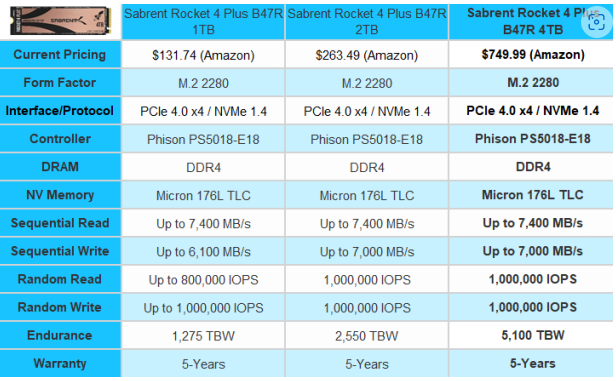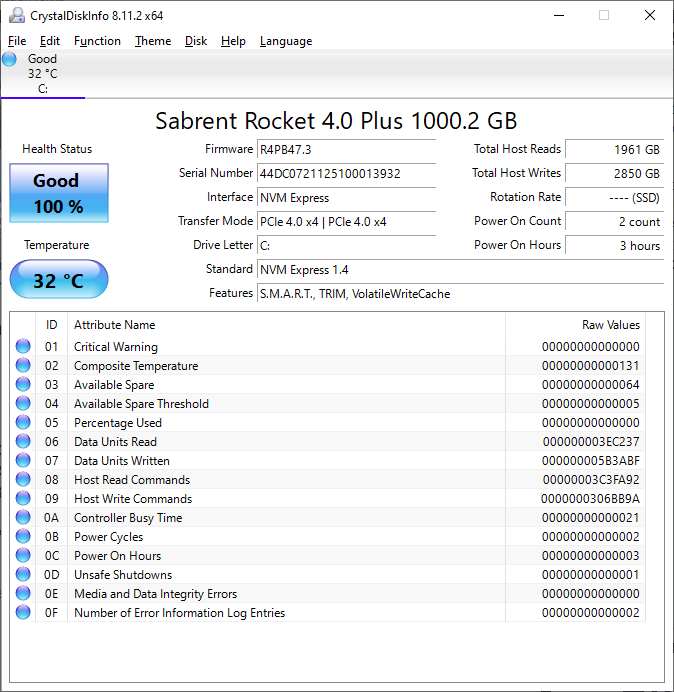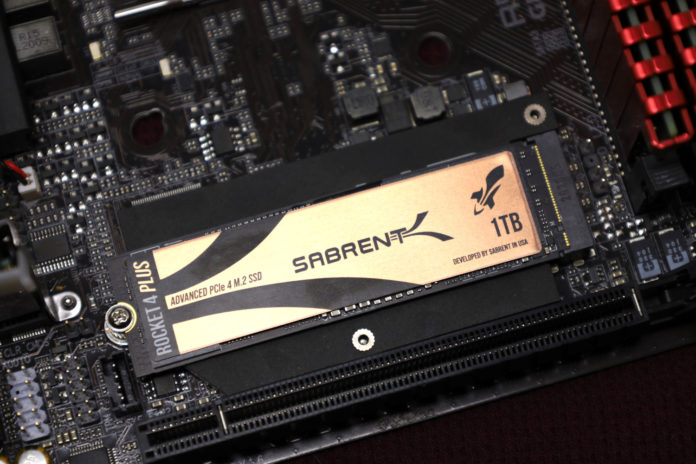Today we are taking a look at the Sabrent Rocket 4 Plus 1TB NVMe SSD. We have previously reviewed the 2TB Rocket 4 Plus drive, but we are doing this review for two reasons. The first is that we have standardized on 1TB models for most of our performance testing and I wanted to be able to include the Rocket 4 Plus in our competitive graphs. This same reason is why we will soon be re-reviewing the Samsung 980 Pro 1TB, so stay tuned for that one. The second reason is that Sabrent has actually changed the NAND used in the Rocket 4 Plus since the initial release, and according to them performance has improved. Another 2TB Rocket 4 Plus was sent over and we will look at that drive in a later article and perform a head-to-head comparison between the old and new drives. For now, we will get to testing and see how the current Rocket 4 Plus 1TB performs.
Sabrent Rocket 4 Plus 1TB NVMe SSD
The Sabrent Rocket 4 Plus 1TB comes in a single-sided M.2 2280 (80mm) form factor. This front label is a thin metal heatspreader that can help keep the drive cool under a light load. We will learn more about that in thermal testing.

The Sabrent Rocket 4 Plus bundles Micron 176-layer TLC NAND with the Phison PS5018-E18 controller. This is an identical setup to the Seagate FireCuda 530. This is a top-flight set of components and my performance expectations are very high for this drive.

The rear side of the drive has nothing except a label.
Sabrent Rocket 4 Plus SSD Specs
The Sabrent Rocket 4 Plus line of SSDs is available in sizes between 1TB and 8TB.

This spec sheet has been updated for the 176-layer variant of the Sabrent Rocket 4 Plus. Right now on the Sabrent website for the Rocket 4 Plus the specs are for the original version of this drive and has not been updated yet; I am told they are working on fixing that. While I am not a fan of changing drive components without issuing a new SKU, at least when Sabrent has done it here the specs are improving rather than getting worse, as well as acknowledging the change and updating the spec sheet. If you own one of the Rocket 4 Plus drives and are curious as to which model you own, the Sabrent Control Panel application can help you identify your drive. The original version of the Rocket 4 Plus has not been in distribution for about half a year, so new purchases of the Rocket 4 Plus should all be the new version.
Getting to those specs, the Rocket 4 Plus 1TB has all the rated performance of a top-end PCIe 4.0 SSD, with sequential reads at 7400 MB/s and writes at 6100 MB/s. The original variant of this drive was only rated at 7000/5300 respectively, so the improvement in specifications is not trivial. Even better than that is the very high 1275 TBW endurance rating; the original Rocket 4 Plus 1TB only had a 700 TBW rating. Lastly, the drive comes with a standard 5-year warranty which is the preferred length of warranty for a premium drive.

CrystalDiskInfo can give us some basic information about the SSD and confirms we are operating at PCIe 4.0 x4 speeds using NVMe 1.4.
Test System Configuration
We are using the following configuration for this test:
- Motherboard: ASUS PRIME X570-P
- CPU: AMD Ryzen 9 5900X (12C/24T)
- RAM: 2x 16GB DDR4-3200 UDIMMs
Our testing uses the Sabrent Rocket 4 Plus 1TB as the boot drive for the system, installed in the M.2_1 slot on the motherboard. The drive is filled to 85% capacity with data and then some is deleted, leaving around 60% used space on the volume.
Next, we are going to get into our performance testing.





@servethehome
Your post cache write shows around 2GB/s
When Guru3D tested this same drive they get around 500 MB/s
Any comments on this large discrepancy please?
No idea how they test them Rodigas, but Will saw the same with the FireCuda and we had other folks verify at that time. This uses the same controller and ends up with virtually the same performance. I cannot comment on why other sites get different results.
Rodigas, STH definitely uses different testing methodology here than Guru3D. I use 10 separate running instances of an external utility to generate and write random data comprising 85% the capacity of the drive – so about 850GB in the case of a 1TB drive. This is done at the beginning of benchmarking when the drive is blank except for the copy of Windows and various benchmarks that are installed. I then monitor both drive temperature and write speed near the end of that process to see what it settled at. If the drive begins throttle during the test, or just starts to get uncomfortably warm, I reset the drive and perform the test again with a heatsink and airflow.
With that said, it is hard to truly understand what is happening over on Guru3D because parts of their review are self contradictory. As an example, they list the test environment and equipment as using a Ryzen 9 5950X-based platform, but their Anvil results are obviously taken with an Intel i9-12900K system. They also do not test with their drive set as the boot drive and many of their benchmarks are done with the drive essentially empty. And I have no clue when during their testing they perform this test; if they do the full-disk write at the end of their testing, they might be running into other issues if their drive has not TRIM’d. Their hardware is different, OS is different, and testing is different, so I am not surprised we are running into differences.
Nice review. Slightly surprised that the Samsung 980 Pro series isn’t on the benchmark list for gen4 drives.
Michael – That is, like this one, due to us having tested a different capacity 980 Pro. Will actually has the 1TB 980 Pro already done and that will be the next in his series likely next weekend.
Guru3d 17 or 18 pages for a m2 SSD? WTAF. That’s abusing readers
I think STH should be 2, but i get the breakdown of 3.
Not sure why we’re surprised that 3 year old technology that was top of it’s game is still top of it’s game with minor incremental improvements.
As a relatively new reader I am wondering why all the focus is on sequential read and write results? My understanding is that random read and access time is crucial to how fast a drive will perform and feel in daily use, so it would be nice to see those numbers compared in a graph. The instances where you’d be writing to the drive at 7+GBps in every day use would be small, while you will always be doing random reads and writes for booting, opening apps, saving documents, etc.